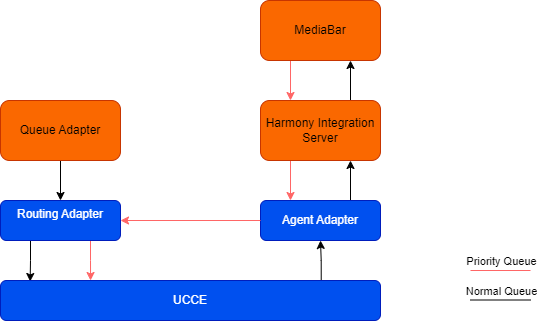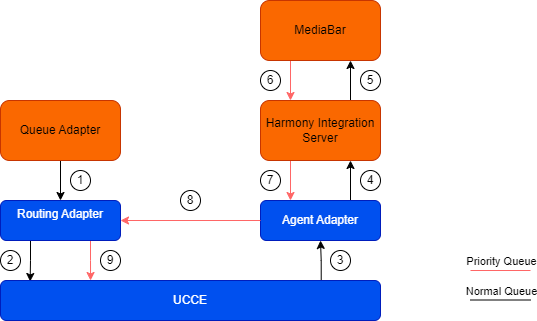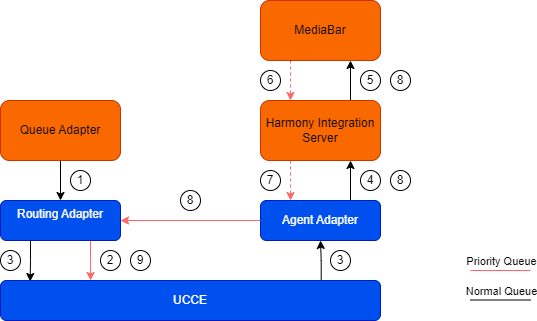Priority Queue
Introduction
All media tasks (email and chat) have a set priority inside the Routing Adapter. This priority defines, which task is sent to the UCCE queue next. There are priorities 1 and 0. Priority 1 is higher than priority 0.
Concept
A task needs to meet certain conditions so that it is treated with priority. If one of the following conditions apply, the task has priority:
- The task is a chat task
- The task was rejected by an agent or was not accepted within the defined timeout (RONA)
Additionally, in the .ini file of the Routing Adapter is a setting, to set the maximum number of tasks that can have priority (MaxQueuedTasksPrioReservation). If this limit is reached, all additional tasks don't have priority.

Example 1 - Single Task with reject

- Queue Adapter sends an email task to the Routing Adapter. None of the conditions apply, resulting in the task not having priority
- The Priority Queue inside the Routing Adapter is currently empty. Routing Adapter sends the email from Queue Adapter to the UCCE queue.
- UCCE selects an available agent and routes the task to the agent.
- Agent Adapter routes the email task to Harmony Integration Server
- Harmony Integration Server sends the email task to the MediaBar, where the agent can now accept the task.
- The agent rejects the task, resulting in the task being sent back to Harmony Integration Server.
- Harmony Integration Server sends the task back to Agent Adapter.
- The Agent Adapter sends the rejected task to the Routing Adapter with priority.
- Since the rejected task has priority, it is put into the Priority Queue. The Priority Queue was empty, so the task is at position 1 and gets sent to the UCCE queue.
Example 2 - 3 Tasks (email and chat) with RONA, MaxQueuedTasks = 2 und MaxQueuedTasksPrioReservation = 1

- Queue Adapter sends 2 email tasks (Email A and Email B) and 1 chat task (Chat A) to Routing Adapter. The chat task (Chat A) is given priority, since one of the priority conditions applies. The email tasks (Email A and Email B) have no priority.
- The chat task (Chat A) is sent to the UCCE Queue because it is in the Priority Queue.
- The chat task (Chat A) is routed to an available agent via Agent Adapter. Routing Adapter then sends the first email task (Email A) to the UCCE queue.
- Agent Adapter sends the chat task (Chat A) to Harmony Integration Server.
- Harmony Integration Server sends the chat task (Chat A) to the MediaBar, where the agent can now accept the task.
- / 7. The chat task (Chat A) is not answered by the agent within the configured timeout (RONA). Subsequently, the Agent Adapter 'takes' the task (Chat A) back.
- The chat task (Chat A) is sent to Routing Adapter with priority. The first email task (Email A) is now routed to the agent.
- The chat task (Chat A) is in Priority Queue at position 1 and the second email task (Email B) is in the normal queue. Priority Queue is processed first, so the chat task (Chat A) is sent to UCCE